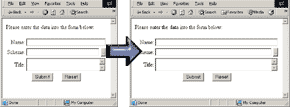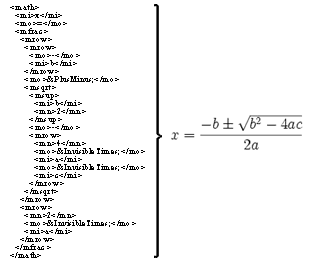Dave Doyle
Having become a web developer during the early days of
the Internet, when few knew about it and even fewer standards existed,
I have engaged in quite a bit of research throughout the years. A summary
of my research in the use of the web in education, educational software
development and alternative forms of UI is included here.
Note: details of some of the research
have been obscured for confidentiality reasons
Adaptable, space-recapturing form layout (2006)

Traditional web-based form design establishes a size for each field within the form. Users cannot lengthen form fields to make it easier to type additional data. This is contrary to the browser experience as they can lengthen their browser in order to view more non-form-based information at a glance. However, by using CSS to set the width of the input fields, users can modify the amount of space available to them within the field by resizing the browser.
Real-time updates with JSF/AJAX (2005)
Modern web application trends have moved away
from the web paradigm of transitioning from page to page. To have a completely
usable web application that could be used with no delays, jarring transitions
or breaking of the application metaphor, changes have to be made in the
technologies used. This was the reason that AJAX (Asynchronous JavaScript
and XML) was created. By incorporating AJAX into standard JSF (Java Server
Faces), this complexity of design can be hidden within encapsulated components,
allowing traditional web developers to use the functionality without being
aware of it.
Enterprise Reporting Packages vs Ad-hoc (2005)
A comparison of common enterprise reporting software
and their abilities. These abilities are compared against the needs and
wants of actual users through use of user interviews and questionnaires.
Once the feature set was established, a cost analysis was done comparing
how much it would cost to develop an equivalent system in house and the
likelihood of continual funding to create all features. This research
also detailed the developer skills and interests necessary to create an
in-house system and compared them to the characteristics of developers
already hired to create other software.
Cost-effective UI Farming (2005)
An exploration of how a relatively small user
interface development group could oversee a large number of UI projects
and maintain a standard look, feel and quality of interface without becoming
a bottleneck in the overall development process. This research explored
how to farm out parts of UI development to non-UI developers, and what
parts of this process would still need to remain with a UI group
or be overseen by it.
Embedding math within a webpage (2003)

Using COM and behaviors, I helped develop a browser plug-in that allows a page developer to embed MathML in their webpages. Doing this allows a mathematical formula to be rendered within the page. This is the only UI assignment I had where my work was to make the interface completely invisible.
Usable sites need not always fit the clean, white
look given by businesses, nor do sites evoking an emotion need to be
unusable. A selection of test cases demonstrates how to merge the two,
creating usable and readable websites that are atmospheric in design.
more >
Selling Web Services in an Uncertain Economy
(2001)
Essentially I found that
web-based store owners are still likely to put forth money into a web-based
presence if we can provide them with features found in real-world counterparts.
This base can also be augmented with features suggested by the customers
themselves.
Educational Psychology Thesis - "Categorization
of Student Learning Styles and Individual Differences and Their Application
to a System of Computerized Individualized Learning" (1999)
Specific individual differences in learning style
can be used as input to an automated lesson delivery system. By using
these specific parameters, appropriate lessons can be chosen for the
student.
Computer Science Thesis - "Design of
a Lesson-Delivery Mechanism using ATI Variables." (1999)
The assertion posited by my educational psychology
thesis is demonstrated and expanded to show how a system can be made
to also meet teacher, principal, school administration and parental
needs. This computer framework also demonstrates how this can
lead to an educational system that cannot degrade in teaching
ability.
Self-cleaning windows combined with embedded
glossary (1998)
By attaching a hyperlink to JavaScript methods,
glossary functionality can be embedded into a page. The definition of
terms can then be opened up in a small pop-up window. To avoid unnecessary
windows needing to be closed by the user, the script quietly cleans up
the popup in the background once that window loses focus. demo >
Problems with traditional methods of learning
computer programming come from trying to teach a process that is generally
non-linear, with a static, linear description. Applying animation to
the content to be learned allows users to 'step through' a program
or concept in order to more fully understand what happens at each step.
more >
The advantages brought about by separating data
from presentation and programmatically developing an interconnected
and organized website by using an engine and templates to convert this
data into standard HTML. more >
Ampere's Law (1998)
A prototype of a college physics tool teaching Ampere's law. I served as one
of the developers and the lead for the development. more >
Early Learning Physics Book (1998)
A graphics project using GLUT to teach physics
to elementary school students. I worked as one of the three developers
on the project. more >
Emotionally-based evaluation (1997)
A demonstration of how the strength of a user's
emotions can be utilized as an effective way to quantitatively capture
data. This project, written in Java, shows how the emotions caused
by the enjoyment or frustration of an instructor's style and ability
can more accurately translate into data than would asking students
to fill in the standard questionnaire. download >
Use of the web as an instructional medium (1997)
My presentation to the International Consortium
of Courseware Engineers exploring how educational content presented on a
website removes many constraints and offers unique opportunities not available
via standard learning situations. download >